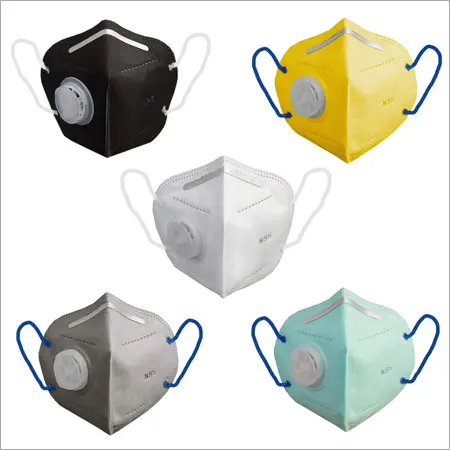A Comprehensive Look at N95 Masks vs. Surgical Masks

As an instance of personal protection equipment, surgical masks, and N95 respirators are two types of masks that are intended to shield the wearer's face from being contaminated by liquid or solid particles, respectively. The NIOSH, which is part of the CDC, is also responsible for regulating the best n95 mask for covid. OSHA is responsible for regulating companies to ensure that they comply with worker safety laws and OSHA standards. This includes ensuring that respirators are used correctly in a variety of various work situations. It is essential to be aware of the fact that using a mix of treatments from all over the control hierarchy, as opposed to personal protective equipment on its own, is the most effective strategy to stop the spread of infectious microbes like viruses.
Guidelines From the CDC For the Public in General
For suggestions about the usage of masks, please visit the CDC's online resource page. The Centres for Disease Control and Prevention (CDC) has signed an order that will take effect on February 2, 2021, mandating the use of face masks on all forms of transport traveling into, to it, or even out of the U. S., as well as in transport hubs inside the U. S. such as airport terminals and railway stations.
Face Masks
This is an item that covers not only the wearer's mouth but also their nose. In line with suggestions made by the CDC, face masks are not considered to be personal protective equipment since they are intended for use as version control systems by both the wider populace and medical care workers (HCP).
Barrier Face Coverings
A blocking face covering is a result that is worn on the face and particularly covers at least the wearer's nose and mouth. The principal goal of a barrier face coating is to continue providing engineering controls and to provide some degree of particle filtration to decrease the consumption of inhaled suspended particles. The use of barrier face veils is not an acceptable replacement for the use of best n95 masks for covid as well as other Filtration Facepiece Respirators, which offer the wearer protection against respiratory hazards, or for facemasks, which offer the wearer protection against fluid barriers and particulate materials. There is a wide selection of non-combustible materials which may be used in the production of barrier face coverings.
Surgical Masks
This is a one-time-use device that has a loose fit and is made of disposable material. Its purpose is to establish a physical barrier across the wearer's mouth and nose and any possible pollutants in the surrounding environment. It is against the rules to exchange surgical masks, which may be identified as being used for dental work, medical procedures, isolation, or surgery. As was said above, they are also commonly known as face masks; however, not every face mask is considered to fall within the category of face masks. Surgical masks may come in a variety of thicknesses, each of which offers a unique level of protection against the transfer of liquids to the wearer. The ease with which you can inhale thru the face mask and the degree to which the surgical mask covers you may also be impacted by these characteristics.
Wearing a protective mask can also help limit the likelihood that others will come into contact with your saliva or respiratory secretions. Face masks, unlike surgical masks, are not designed to block or restrict very tiny airborne particles. These particles can be spread through coughing, sneezing, as well as certain medical procedures. A surgical mask may help prevent splashes and huge droplets from entering the wearer's respiratory tract. Surgical masks should not be reused once they have been used the first time. When the surgical mask is dirty or damaged, or if it becomes difficult for you to breathe while wearing it, you should take it off, dispose of it securely near, and put on a fresh mask. If you want to get rid of your surgical mask securely, put it in a trash bag first and then throw it away. After removing the used mask, you should wash your hands.
N95 Respirators
Respiratory protection equipment such as an n95 mask is intended to provide a very snug fit to the user's face while also providing very effective filtering of particles in the air. It is important to keep in mind that the sides of the mask are intended to create a barrier all around the wearer's breathing and nose. These respirators are frequently used in hospital environments.

All Colors Choice N95 Face Mask With Respirator - 5 Layer
Price: 11.00 INR
Minimum order quantity - 50 Piece/Pieces
Examining The Differences Between Surgical Masks & Surgical N95 Respiratory Protection
The FDA has separate regulations for facemasks and surgical n95 masks, and these regulations are depending on the planned use of the masks & respiratory protection. A surgical facemask is a one-time-use device that has a loose fit and is made of disposable material. Its purpose is to establish a physical barrier separating the wearer's nose and mouth and any possible pollutants in the surrounding environment. Although many people refer to them as face masks, it's important to note that not every face mask is considered to be a surgical mask. The respiratory protection equipment known as an N95 respirator is intended to provide a very snug fit to the user's face while also providing very effective filtering of particles in the air. It is important to keep in mind that the sides of the mask are intended to create a barrier all around the wearer's nose and mouth.
General Safety Instructions For The N95 Respirator
Because wearing an N95 respirator could indeed make it much harder to breathe, patients with chronic breathing, cardiovascular, or other health problems that already make it difficult to breathe should consult with their primary care physician before using an N95 respirator. Expiratory valves are available in certain types, and they facilitate simpler exhalation while also assisting in the prevention of heat accumulation. It is worth noting that N95 respirators that include breathing valves will not be utilized in environments that require aseptic settings. Also, be sure to choose the right n95 mask manufacturers.
All N95 respirators that have been certified for use by the FDA are designated on the packaging as "single-use" devices that are disposable. When your mask is dirty or damaged in any way, or if it becomes difficult for you to breathe while wearing it, you should take it off, dispose of it appropriately, and put on a new respirator. If you want to get securely rid of your N95 respirator, put it in a trash bag first and then throw it away. After removing the used respirator, you should clean your hands thoroughly. Kids and persons with facial hair are not intended to use N95 respirators since they are not built for them. There is a possibility that the N95 respirator will not provide complete protection to youngsters or persons who have facial hair depending on the n95 mask manufacturers since it is impossible to find a perfect fit for them.
Read More About: Top 10 Best Quality Face Mask Manufacturers, Suppliers & Exporters in India
Respirators with the N95 Standard Used in Industrial and Healthcare Settings
The vast majority of N95 respirators are designed for use in the construction industry as well as other types of industrial activities that put employees in danger of being exposed to dust and other microscopic particles. The NPPTL of NIOSH, which is a component of the Services for Disease Protection and Management, is in charge of regulating these items (CDC). On the other hand, there are N95 respirators that are designed specifically for use in medical facilities. To be more specific, respiratory protection devices that are single-use and disposable are worn by healthcare staff during operations to safeguard both the patients and the healthcare practitioners from the transmission of germs, bodily fluids, and particle debris. This will also be based on the n95 mask price, as cheaper ones won't provide all the utility. N95s respirators are considered class II medical devices and are exempt from the 510(k) premarket notification requirement unless one of the following conditions is met:
- It is the purpose of the respirator mask to protect the user from certain illnesses or infections.
- Coating technologies that are not connected to filtration are included in the respirator.
The FDA and the NIOSH have signed an MOU that explains the structure for consultation and cooperation between the FDA and NIOSH regarding the regulations of this subcategory of N95 ventilators. So, when buying one for yourself make sure not to skimp out on the n95 mask price.
To prevent the spread of the disease and save people, masks are included in a complete plan of prevention methods. When it comes to providing an effective degree of protection against COVID-19, the use of a mask by itself is not enough but it certainly helps. So that was everything about the different kinds of facemasks. We hope this article has provided youth with the information you needed.
FAQs: N95 Masks vs. Surgical Masks
Q. During the COVID-19 event, am I allowed to use face masks that include exhalation valves?
Ans. It is not recommended to use masks that include vents or expulsion valves since these features enable unfiltered air to leave the mask. Use the n95 mask in India for best results.
Q. What exactly is an N-95 mask?
Ans. A respirator mask with an N-95 rating has high filtration effectiveness against airborne particles and is used as a kind of respiratory protection. These n95 masks in India are intended to produce a very tight face fit to provide the necessary air seal for the person who is wearing them.
Explore More:
